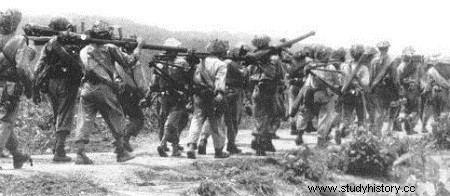
During the subsequent cleanup, the French discovered and destroyed deposits arms and food. On November 16, after a week of marches and fighting, the paratroopers were evacuated by truck to Hanoi. However, the Viet Minh was quick to react, and an ambush set up by two Régts. intercepted elements of the rearguard, destroyed their trucks, tanks and caused them certain losses. The lesson, which was to prove its validity in the two Indochinese conflicts, was that, while it was relatively easy to penetrate to enemy bases, it was essential that the raiding forces not linger so as not to give the enemy time to react, regroup and counter-attack.
The following spring, the Viet Minh push against Laos had failed, and a certain parity which had been established between the two parties prompted the French to attempt another raid against the enemy's supply lines. The chosen objective was the town of Lang Son, a staging and distribution base, located near the Chinese border, deep in the depths of enemy territory.
The air interdiction applied to the roads supply from Lang Son had produced a bottleneck in the supply chain, and the resulting accumulation of provisions and ammunition had been assembled north of the city in bombproof shelters.
This raid must have been far more difficult than the previous one, because not only did the town and the shelters have to be captured, but between the objective and the nearest friendly lines stretched more than 70 km of mountainous terrain, wooded and almost devoid of communication routes.
The opposing forces consisted of a Bn. local and two companies. provincials at Lang Son, while at the Chinese border, which was only 10 km away, there were a few light AA units. Elements of the 308th Div. of Inf. were 48 hours away in Thai Nguyen. More worrying still, in the 70 km of hostile territory between Lang Son and Tien Yen, the nearest French post, a total of 8 Companies. provincials could be engaged on the first day and from 4 to 6 after the second day.
General Gilles had been given command of the operation which had been baptized "Swallow" and had been divided into three phases:first, the airdrop on July 17 followed by the destruction of the Lang Son depots; second, the capture of a bridge over the Song Ky River, near Loc Bink, to cover the retreat; and third, an overland ope-ration beginning on the 17th at Tien Yen and pushing northwest on a Tien Yen-Dinh Lap axis. This was intended to reduce the distance between airborne troops and friendly forces.
In the 1860s, the Empire no longer had the aura it had at its beginnings. Its loss of power abroad stemmed largely from its failed attempt to overthrow a republic and set up a Latin Empire in Mexico in favor of Archduke Maximilian of Austria in 1863. The Empire embarked on colonization experiences f
